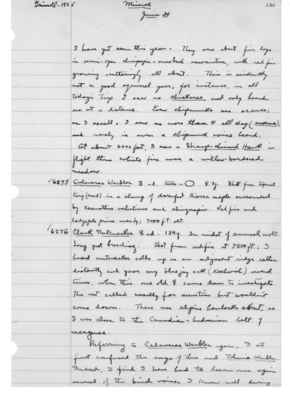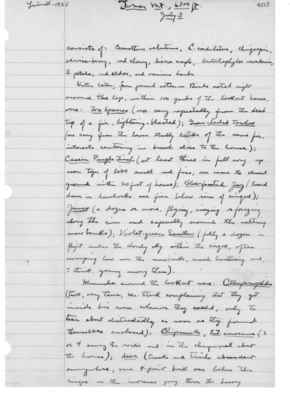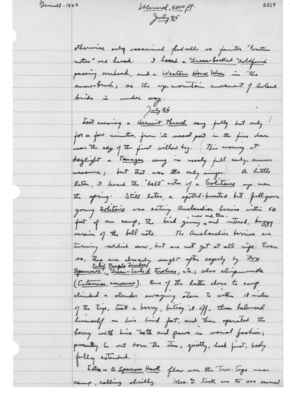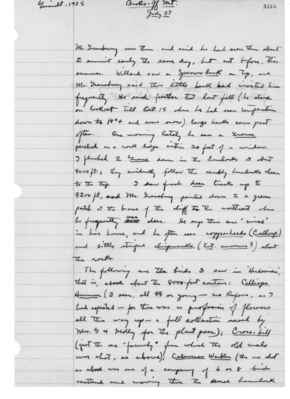Pages That Mention Tamias amoenus
1925: Joseph Grinnell's field notes
S2 Page 25
Author: Grinnell-1925 Location: Mineral, 4800 ft. Date: June 19 Page Number: 2480
Later: found the Traill Flycatcher's nest some 7 feet up in a crotch of slender willow stem in the midst of an isolated willow clump in the meadow - just in process of construction. In a tract of old lodge pole pines a little farther along, a crowd of birds was distraught over something, tho I failed to find what the threatening danger was. The crowd included: Juncos, a pair of Robins, a Lincoln Sparrow, a Pigmy Nuthatch (the first I have seen in the Lassen "section"), a Hammond (or Wright) Flycatcher, several Chipping Sparrows, and a pair of Audubon Warblers. Nearby was a (female) White-headed Woodpecker.
As to mammals: winter earthcores of Thomomys monticola occur in places where the ground is well-drained at the sides of meadows but not out in them. The common chipmunk is Eutamias amoenus, about logs overgrown with snowbushes, but they are very quiet now; two visit camp, but so far are shy. A (female) Eutamias senex was trapped in a neighbor's camp yesterday morning at 5 o'clock. Last evening just before sundown, Dixon shot an old male jack-rabbit (Lepus c. californicus) in a tract of sparse snowbush. Mrs. G. has seen another partly grown one in the same vicinity. This must be the extreme easternmost limit of this subspecies in the "section". Also, Mrs. G. and Dixon have both seen individuals of the snow-shoe rabbit (Lepus w. klamathensis).
S2 Page 58
Collector: Grinnell - 1925 Location: Mineral Date: June 30 Page Number: 2511
I have yet seen this year. They were about fir logs in semi-open chinquapin-snowbush association, with red fir growing scatteringly all about. This is evidently not a good squirrel year; for instance, in all today's trip I saw no chickaree, and only heard one at a distance. Even chipmunks are scarce; as I recall, I saw no more than 4 all day (amoenus), and rarely is even a chipmunk voice heard.
At about 6000 feet, I saw a Sharp-shinned Hawk in flight thru the white firs near a willow-bordered meadow.
6275 Calaveras Warbler [male symbol] ad. testes - [testes illustration] 8.3 g, Shot from topmost twig (dead) in a clump of dwarfed Sierra maple surrounded by ceanothus velutinus and chinquapin. Red firs and lodgepole pine nearby; 7000 ft. alt.
6276 Clark Nutcracker [female symbol] ad. 134 g. In midst of annual molt. Long past breeding. Shot from red fir at 7500 ft.: I heard nutcracker calls up on an adjacent ridge rather distantly and gave my bluejay call (Kochwish) several times, when this one old [female symbol] came down to investigate. The rest called nasally for sometime but wouldn't come down. There were alpine hemlocks about, so I was close to the Canadian-hudsonian belt of mergence.
Referring to the Calaveras Warbler again, I at first confused the songs of this and Tolmie Warbler. Indeed, I find I have had to learn over again several of the bird voices I knew well during
S2 Page 64
Collector: Grinnell - 1925 Location: Turner Mt., 6300 ft. Date: July 3 Page Number: 2517
consist of: Ceanothus velutinus, C. cordulatus, chinquapin, service-berry, red cherry, Sierra maple, Arctostaphylos nevadensis, A. patula, red alder, and various herbs.
Written later, from pencil notes. - Birds noted right around the top, within 100 yards of the lookout house, were: Fox Sparrow (one sang repeatedly from the dead tip of a fir, lightning-blasted); Green-tailed Towhee (one sang from the lower stubby limbs of the same fir, interests centering in the brush close to the house); Cassin Purple Finch (at least three in full song up near tops of live small red firs, one came to cleared ground within 20 feet of house); Blue-fronted Jay (heard down in the hemlocks and firs below rim of cirque); Junco (a dozen or more, flying, singing or foraging along the rim and especially around the melting snow banks); Violet-green Swallow (fully a dozen in flight under the cloudy sky within the cirque, often swooping low over the snowbanks, much twittering and, I think, young among them.
Mammals around the lookout were: Callospermophilus (two, very tame, Mr. Stark complaining that they got inside his room whenever they could, only to tear about distractedly as soon a they found themselves enclosed), Chipmunks, Eut. amoenus (3 or 4 among the rocks and in the chaparral about the house); deer (tracks and tails abundant everywhere, one 4-point buck seen below the cirque on the moraines going thru [sic] the heavy
S2 Page 76
Collector: Grinnell - 1925 Location: Mineral, 4800 ft. Date: July 25 Page Number: 2529
otherwise only occasional food calls or fainter "location notes" are heard. I heard a Green-backed Goldfinch passing overheard, and a Western House Wren in the snow-brush; so the up-mountain movement of lowland birds is under way.
July 26 Last evening a Hermit thrush sang fully but only for a few minutes, from its usual post in the firs down near the edge of the first willow bog. This morning at daylight a Tanager sang in nearly full early summer measure; but that was the only singer. A little later, I heard the "bell" notes of a Solitaire up near the spring. Still later, a spotted-breasted but full-grown young Solitaire was eating Amelanchier berries within 50 feet of our camp, the bird giving ^now and then an intoned, buzzy version of the bell note. The Amelanchier berries are turning reddish now, but not yet at all ripe. Even so, they are already sought after eagerly by Fox Sparrows, ^Calif. Purple Finches, Green-tailed Towhees, etc; also chipmunks (Eutamias amoenus). One of the latter close to camp climbed a slender swaying stem to within 18 inches of the tip, took a berry, biting it off, then balanced himself on his hind feet, and then operated the berry with his teeth and paws in usual fashion; presently he went the stem, quietly, head first, body fully extended.
Later - A Sparrow Hawk flew over the tree-tops near camp, calling shrilly. Mrs. G. took me to see several
S2 Page 79
Collector: Grinnell - 1925 Location: Broke-off Mt. Date: July 27 Page Number: 2532
Mr. Gransbury saw them and said he had seen them about the summit early the same day, but not before, this summer. Willard saw a Sparrow Hawk on top, and Mr. Gransbury said this little hawk had visited him frequently. He said further that the last fall (he staid on lookout till Oct. 15 when he had seen temperatures down to 14°+ and some snow) large hawks came past often. One morning lately he saw a Grouse perched on a rock ledge within 20 feet of a window. I flushed 2 Grouse down in the hemlock at about 9000 ft.; they evidently follow the scrubby hemlocks cleans to the top. I saw fresh deer tracks up to 9200 ft., and Mr. Gransbury pointed down to a green patch at the base of the cliff to the northeast where he frequently sawsees deer.He says there are "mice" in his house and he often sees copperheads (Callosp.) and little striped chipmunks (Eut. amoenus?) about the rocks. The following are the birds I saw in "Hudsonian" that is, about the 8000-foot contour: Calliope Hummer (3 seen, all [female symbol] [female symbol] or young - no Rufous, as I had expected - for there was a profusion of flowers all the way up - a full collection saved by Mrs. G. & Molly for the plant press); Cross-bill (just the one "family" from which the old male was shot, as above); Calaveras Warbler (the one shot as above was one of a company of 6 or 8 birds scattered and moving thru [sic] the dense hemlock




